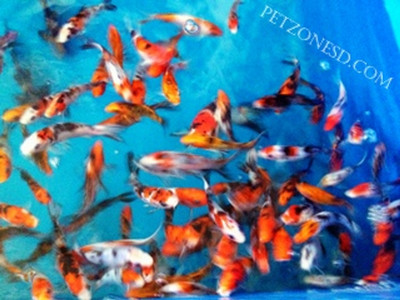Koi Fish: Living Jewels of the Garden Pond
Posted by Max Gandara on on 6th Feb 2024
Koi fish, or Nishikigoi, are a symbol of peace, prosperity, and beauty,
originating from the rice fields of Japan where they were first bred for
their vibrant colors. These ornamental varieties of the common carp
(Cyprinus carpio) have captivated people worldwide, turning koi keeping
into both an art and a science. Revered for their grace, longevity, and
strong individual personalities, koi fish transform any pond into a
living tapestry of color and motion.
Overview and Appearance:
- Scientific Name: Cyprinus carpio
- Family: Cyprinidae
- Size: Up to 36 inches (91 cm), sometimes larger
- Lifespan: 25-35 years, can live up to 50-70 years in optimal conditions
Koi come in a myriad of colors, patterns, and scalation, with some of
the most popular varieties being Kohaku (white with red markings), Sanke
(white with red and black markings), and Showa (black with red and
white markings). Their beauty is the result of meticulous breeding and
careful selection, turning each fish into a unique work of living art.
Habitat and Pond Requirements:
Koi are hardy fish but require a well-maintained pond environment to thrive:
- Water Parameters: Slightly alkaline pH (7.5-8), with a temperature
range of 35-85°F (2-29°C). Koi are cold-water fish but require stable
water temperatures without drastic changes.
- Pond Setup: A minimum of 1,000 gallons for a small collection,
with an additional 100-200 gallons per added Koi. The pond should have a
depth of at least 3 feet to provide respite from weather extremes. Good
filtration, aeration, and regular pond maintenance are crucial for
water quality and the health of the fish.
- Plants and Decor: Koi ponds can include aquatic plants, but be
aware that koi might nibble on them. Submerged rocks and gravel provide
beneficial bacteria habitats for water filtration, but koi don't need
these for hiding as they are not generally shy.
Diet and Nutrition:
Koi are omnivorous and have hearty appetites:
- A balanced diet of high-quality koi pellets or sticks as the staple.
- Regular servings of fruits, vegetables, and protein sources like worms
or small crustaceans to mimic their natural diet and provide
enrichment.
- Avoid overfeeding and monitor water quality, as koi can produce a significant amount of waste.
Behavior and Social Interaction:
Koi are social and enjoy living in groups. They can be trained to eat
from your hand and recognize their caretakers, often greeting visitors
with gentle ripples at the water's surface.
- Suitable for communal ponds with other koi or hardy goldfish varieties.
- They can become quite tame and interactive with their owners.
Breeding:
Breeding koi can be a complex but rewarding endeavor, often best left to experienced hobbyists:
- Spawning usually occurs in the spring when water temperatures rise.
- Providing a spawning area with brushes or plants can encourage egg-laying.
- Eggs and fry are vulnerable and should be protected from adult koi and pond predators.
Koi fish are more than just pets; they are a living art form and a
centerpiece of water garden aesthetics. Their serene presence, vibrant
colors, and interactive nature make them a symbol of tranquility and
beauty in the aquatic world. Proper care, a well-designed pond, and a
balanced diet can ensure these magnificent creatures live a long,
healthy life. Whether you are a seasoned koi enthusiast or new to the
hobby, the journey of koi keeping is one of continuous learning,
fulfillment, and connection with nature's remarkable creations.

